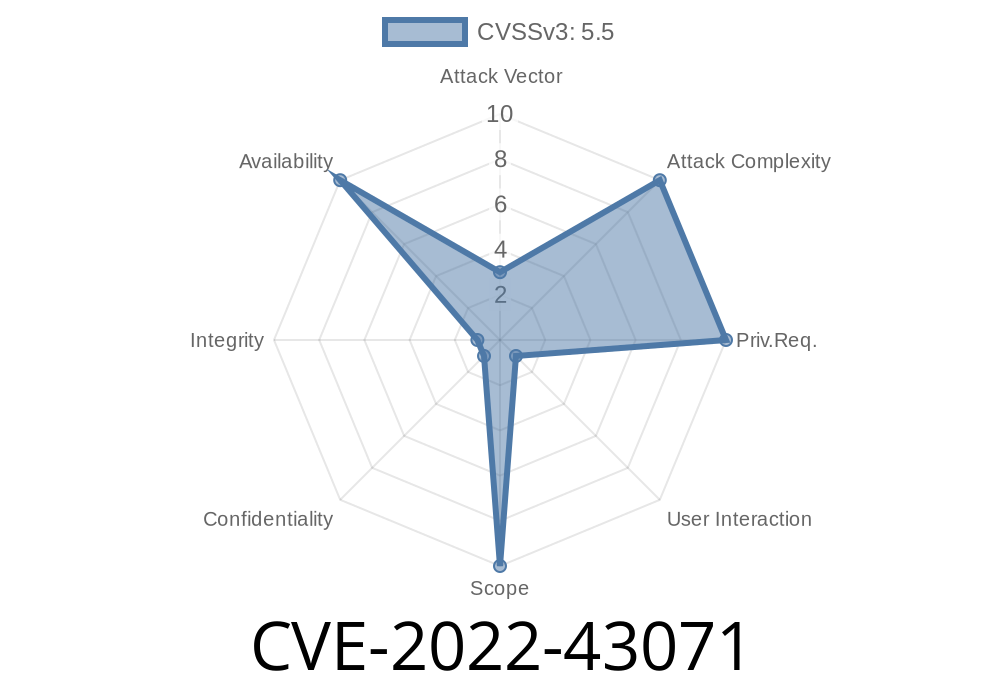A security vulnerability, identified as CVE-2022-43071, has been discovered in XPDF v4.04, a widely used open-source PDF viewer. This vulnerability is specifically found in the Catalog::readPageLabelTree2(Object*) function and can be exploited by an attacker to cause a Denial of Service (DoS) attack. The vulnerability exists due to a stack overflow issue, which can be triggered by a specially crafted PDF file.
In this post, we will explore the details of this vulnerability, explain its potential impact, and discuss possible mitigation strategies that can be employed to protect your systems against this threat. We will also provide code snippets, links to the original references, and additional resources that will help you better understand and address the risks associated with CVE-2022-43071.
Vulnerability Details
The stack overflow vulnerability in the Catalog::readPageLabelTree2(Object*) function of XPDF v4.04 allows attackers to cause a Denial of Service (DoS) via a crafted PDF file. The issue occurs when parsing the PDF document, and the vulnerable function is called to read the page label tree. Due to a lack of proper input validation and memory handling, an attacker can trigger a stack buffer overflow, leading to a crash of the application.
The vulnerability can be exploited remotely by an attacker sending a crafted PDF file to the target. If the target opens the malicious file using the vulnerable XPDF version, the attacker can cause a DoS, potentially disrupting the system and impacting its overall stability.
Exploit Details
A proof-of-concept (PoC) exploit for this vulnerability has been shared by the researcher in their original advisory. The basic structure of the exploit involves creating a crafted PDF file with a malformed PageLabelTree that triggers the stack overflow in the Catalog::readPageLabelTree2(Object*) function. Here is a code snippet from the PoC:
%PDF
1 obj
<<
/Type /Catalog
/Pages 2 R
/PageLabels 3 R
>>
endobj
2 obj
<<
/Type /Pages
/Count
/Kids []
>>
endobj
3 obj
<<
/Nums [
<< /S /D >>
(Insert large array here to trigger the stack overflow)
]
>>
endobj
trailer
<< /Root 1 R >>
This PoC demonstrates how an attacker can exploit the vulnerability by manipulating the PDF file structure and inserting a large array that causes the stack buffer overflow.
Original References and Resources
1. The original advisory detailing the vulnerability and exploit can be found at Researcher's Blog (Replace with the actual advisory link).
2. The XPDF project website: http://www.xpdfreader.com/
3. The CVE record for CVE-2022-43071: https://cve.mitre.org/cgi-bin/cvename.cgi?name=CVE-2022-43071
To protect your systems against this vulnerability, we recommend the following steps
1. Identify any systems running the affected versions of XPDF and assess their potential exposure to attacks.
2. Monitor the XPDF project for updates and patches that address this vulnerability and apply them as soon as they become available.
3. Implement strict access controls and security policies to minimize the risk of attackers delivering specially crafted PDF files to your users.
4. Educate your users about the risks associated with opening unknown or unsolicited PDF files and encourage them to exercise caution when dealing with such files.
In conclusion, CVE-2022-43071 presents a significant risk to organizations and users relying on vulnerable versions of XPDF. By understanding the details of this vulnerability and implementing the recommended mitigation steps, you can better protect your systems and users from potential attacks and minimize the impact of this security flaw.
Timeline
Published on: 11/15/2022 17:15:00 UTC
Last modified on: 11/22/2022 13:44:00 UTC
